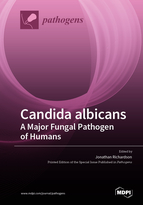Candida albicans: A Major Fungal Pathogen of Humans
A special issue of Pathogens (ISSN 2076-0817). This special issue belongs to the section "Fungal Pathogens".
Deadline for manuscript submissions: closed (30 September 2021) | Viewed by 41790
Special Issue Editor
Interests: host-fungal interactions; fungal virulence factors and pathogenicity mechanisms
Special Issues, Collections and Topics in MDPI journals
Special Issue Information
Dear Colleagues,
Fungal diseases are a significant and growing challenge to healthcare that cause millions of life-threatening infections every year. Candida albicans is typically regarded as a commensal component of the human microbiota but frequently causes superficial infections in otherwise healthy individuals, and invasive life-threatening infections in those with compromised immunity. In 2017, the national cost of Candida-associated hospitalizations was estimated to be $1.4 billion in the USA alone [1]. C. albicans accounts for ~75% of all Candida infections, representing a serious medical challenge for worldwide communities, particularly in the ever-increasing immunocompromised patient population (e.g. chemotherapy, transplants, ICU).
Understanding the biology of C. albicans, how it interacts with the human host, and how it causes disease is of critical importance if we are to engage with and overcome the numerous challenges associated with effective treatment. In this Special Edition of Pathogens, "Candida albicans: a major fungal pathogen of humans" will present recent advances in our understanding of C. albicans in the context of host interaction, infection, and therapeutics.
Potential topics may include (but are not limited to):
- Cell wall biology
- Genomic plasticity and epigenetic diversity
- Regulation of hypha development and contact sensing
- Biofilms
- Mucosal and systemic infection (and associated immune responses)
- Acquisition of micronutrients
- Therapeutics and diagnostics
- Tolerance and resistance to antifungal drugs
- Medical case reports
I look forward to your contributions to this valuable and thought-provoking Special Issue.
Reference
1. Benedict, K., Jackson, B. R., Chiller, T. & Beer, K. D. Estimation of Direct Healthcare Costs of Fungal Diseases in the United States. Clin Infect Dis 68, 1791–1797, doi:10.1093/cid/ciy776 (2019).
Dr. Jonathan Richardson
Guest Editor
Manuscript Submission Information
Manuscripts should be submitted online at www.mdpi.com by registering and logging in to this website. Once you are registered, click here to go to the submission form. Manuscripts can be submitted until the deadline. All submissions that pass pre-check are peer-reviewed. Accepted papers will be published continuously in the journal (as soon as accepted) and will be listed together on the special issue website. Research articles, review articles as well as short communications are invited. For planned papers, a title and short abstract (about 100 words) can be sent to the Editorial Office for announcement on this website.
Submitted manuscripts should not have been published previously, nor be under consideration for publication elsewhere (except conference proceedings papers). All manuscripts are thoroughly refereed through a single-blind peer-review process. A guide for authors and other relevant information for submission of manuscripts is available on the Instructions for Authors page. Pathogens is an international peer-reviewed open access monthly journal published by MDPI.
Please visit the Instructions for Authors page before submitting a manuscript. The Article Processing Charge (APC) for publication in this open access journal is 2700 CHF (Swiss Francs). Submitted papers should be well formatted and use good English. Authors may use MDPI's English editing service prior to publication or during author revisions.
Keywords
- Candida albicans
- fungal infection
- candidiasis
- thrush
- hyphae
- innate
- adaptive
- mucosal
- systemic
- biofilm
- antifungal







